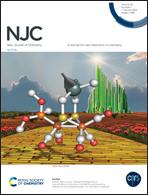The hole transporting behaviour of Cu2AgInS4 and Cu2AgInSe4 for a carbon electrode-based perovskite solar cell†
Abstract
In this work, quaternary Cu2AgInS4 (CAIS) and Cu2AgInSe4 (CAISe) nanoparticles (NPs) were synthesised by a simple hot injection method and were confirmed by XRD and Raman spectroscopy analysis. The morphologies of the synthesised CAIS and CAISe nanoparticles were confirmed by HR-TEM. The synthesised CAIS and CAISe NPs were deposited over pearl carbon (C) coated FTO and this was confirmed by Raman spectroscopy analysis. The photoluminescence (PL) spectra of the perovskite deposited onto CAIS NPs@C and CAISe NPs@C films were recorded to determine their charge extracting behaviour. The PL intensity was quenched on the CAIS NPs@C film and this is consistent with its photovoltaic performance. Among these two hole transporting material, the distribution of CAIS NPs onto a pearl carbon based counter electrode (CE) enhanced the charge transport and charge collection efficiency and reduced the recombination loss more than the CAISe NPs deposited onto a pearl carbon based CE. The synergistic effect of pearl carbon and CAIS NPs reduced the leakage current and increased the charge transport at the pearl carbon/perovskite interface. This enhanced the device performance, which exhibited a maximum PCE of 4.24% with ∼57% improvement over the pearl carbon CE.



 Please wait while we load your content...
Please wait while we load your content...